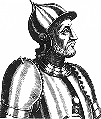History
of Flanders: Line of sand dunes after 9th
century Marshes at or below
sea-level, gradually reclaimed from 7th century low land higher land MAP: Lands of the
Counts of Flanders in the Middle Ages
Counts of
Flanders in the Middle Ages

The
Medieval Counts of Flanders
Draining the Low
Countries
Prosperity in the
medieval wool trade
French
kings fight for control over
Flanders
Flanders
allies with England in the 100 Years
War
Joan of Arc helps
drive out the English
French king vs
ambitious Dukes of Burgundy
Flanders
gains a Hapsburg ruler - and France gives
up
The story
continues on the next
page....
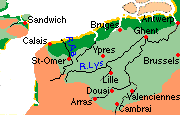
called
the “Low Countries” [les “Pays
Bas”] or the “Netherlands”.
|
Flanders
in the Middle Ages Back in the 9th century, strong local lords with castles and knights on horseback were their only protection from Norman raids, the only saviours of Christianity. While Norman knights ruled England from 1066, the Count of Flanders had castles in Lille, Douai and several other towns - controlling an area including not only the low-lying borders of northern France, but also what is now Belgium and the Netherlands. The Count was supposed to owe loyalty to the king of France, but the king was weak and safely distant. Like lords in other outlying areas such as Brittany in
the west and Burgundy in the east, the Count ruled Flanders
up in the north pretty much as a separate
kingdom. Draining
the "Low Countries" Later in the 15th century engineers fom the northern part
of Flanders called 'Holland' would develop techniques of
using windmill-driven pumps to create 'polders' to drain the
rest of the area and use it for farming. Prosperity
in the medieval wool trade Draining coastal marshes created additional sheep pastures, but increasing amounts of fine long fibred wool had to be imported from England. The wool trade provided over half the English king's tax revenues, collected at ports like Sandwich before it was shipped to Antwerp, Bruges or St-Omer. Inland cloth towns like Lille and Arras were supplied by barges sailing up river. Flanders cloth was sold in international fairs at
Bruges,
Paris
and Cologne. The region
thrived, and towns like Arras became cultural and economic
centres for the Christian world - demanding more
independence from the lords and their taxes.
|
Medieval French kings had difficulty exerting much influence over the Count of Flanders; whereas the Count of Hainaut came under the power of the Empire, and the Cambrai area was dominated by the Church. |
|
French
kings fight for control over
Flanders From their stronghold in Montreiul, they forced Flanders to give up lands in the Artois region, and then beat an Anglo-Flemish alliance at Bouvines (near Lille) in 1214 - a battle which symbolises the French claim to Nord-Pas de Calais. Fighting continued, with bloody confrontations like the Battle of Cassel (1228 - picture R) bringing more of Flanders under French control - but in the process ruining the prosperity of the Artois (around Arras) and driving the trade to the north of the area (around Lille and what is now Belgium and Holland). Bitter anti-French feelings lasted for centuries, and
made sure that both Flanders and Hainault allied with
England through much of the Hundred
Years' War. |
|
|
Flanders allies with England in the Hundred Years' War
|
||||||||||||||||
|
In France and England, a new king often had to fight rivals for the succession to the throne. In 1338, Edward III had a strong claim to inherit the French throne, which he pursued with force. Because of links with England in the vital wool trade, and bitterness over French attacks, the Count of Flanders took England's side at the start of conflict. As lords of a border area, it suited them to play the kings of England and France against each other. Flanders joins
Burgundy... The dying English king Edward III had hoped to strengthen
the Anglo-Flemish alliance by marrying the sought-after
heiress to his fifth son - instead his ally was now
controlled by France. |
|
|||||||||||||||
|
...then Burgundy splits
with the French crown The English took advantage of French divisions to invade again. In 1415 Henry V wiped out the flower of the French nobility at the Battle of Azincourt, and conquered the north and west of France - very nearly succeeding in achieving his grandfather Edward III's ambitions. Burgundy again allied with England, and the weak French king cowered in the south in the small remaining part of his kingdom. Joan of
Arc helps drive out the English |
Charles V is referred to as "Charles Quint" , but in Spain is called "Carlos I" - not to be confused with Carlos V, who came several generations later....
MAP: the split of Burgundy in 1477
MAP: the Unification of France after the 100 Years' War (see Times History Atlas) |
|||||||||||||||
|
Burgundy: the rising star
of Europe |
||||||||||||||||
|
-----Art --------Fressin castle------Arras tapestries |
||||||||||||||||
|
French
king vs ambitious Dukes of
Burgundy While Louis XI wanted to bring Burgundy under his control, Charles the Bold had ambitions to join the north and south parts of his lands - making Burgundy into a "middle empire" between France and Germany. Though France signed peace with England in 1475, fighting
continued with Burgundy, and the Duke's lands in what is now
the Pas-de-Calais were ravaged. Flanders
gains a Hapsburg ruler - France gets Artois In the settlement, Louis XI gained Artois, Picardy and the French part of Burgundy - leaving Maximillian with Flanders and the Bergundian lands in Germany. Facing so strong a foe, Louis XI settled for what he had
gained, and left Flanders to remain in foreign hands for
over two centuries. Meanwhile, Maximillian married their son
to a mad Spanish princess, Juana of Castile. His grandson,
Charles grew up in Flanders. |
|
|||||||||||||||
|
Charles V's
inheritance By 1520 Charles was above all king of Spain - then Europe's most powerful country with wealth pouring in from a new rich empire in America. He could barely speak a word of Spanish, but Flanders, his boyhood home, was henceforth to be just one small part of his realms. Back to top |
||||||||||||||||
|
What
happened to Flanders in the Spanish
Empire? |
||||||||||||||||
|
Places to
visit: |
|
Background information |
|
|
|
|
|
|
|
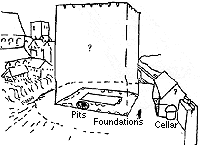
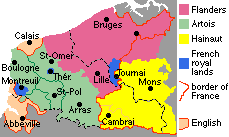
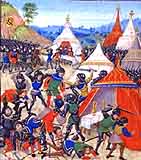
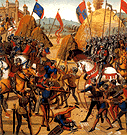
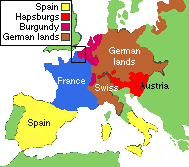
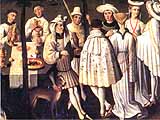 The luxury of the Burgundian court in Flanders: a life of
hunting, jousting, luxury clothes, banquets, music, art and
festivities.
The luxury of the Burgundian court in Flanders: a life of
hunting, jousting, luxury clothes, banquets, music, art and
festivities.